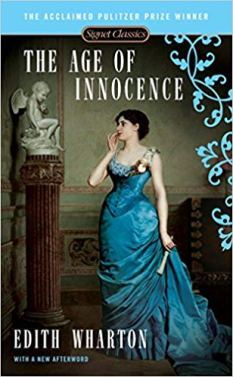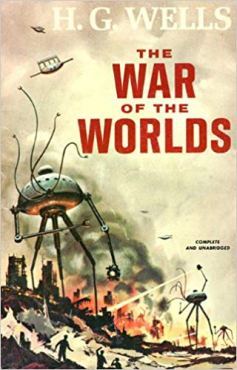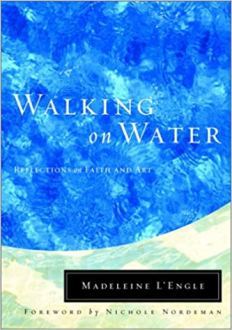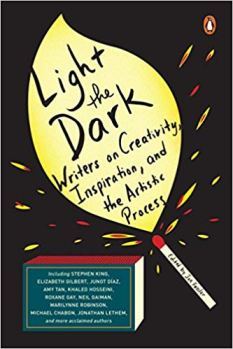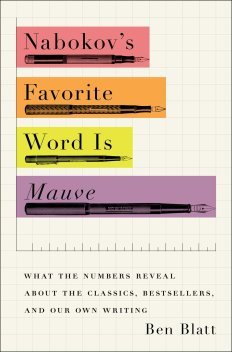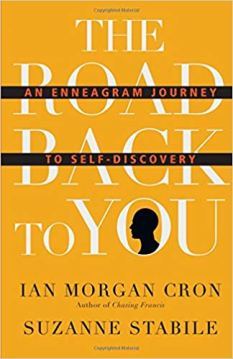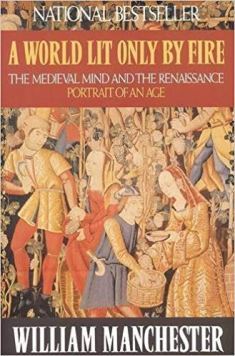K.M. Weiland's Blog, page 37
January 28, 2019
My 9 Writing Goals for the New Year
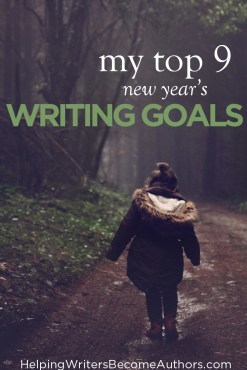 Last year, I wrote about how I don’t really like writing goals. Mostly, this is because they focus on the results and too often bypasses the importance of the journey. But this January, perhaps more than any other January, I find myself brimming with intentional and actionable ideas about where I want this year to take me, as both a writer and a person.
Last year, I wrote about how I don’t really like writing goals. Mostly, this is because they focus on the results and too often bypasses the importance of the journey. But this January, perhaps more than any other January, I find myself brimming with intentional and actionable ideas about where I want this year to take me, as both a writer and a person.
This post is a little late—scraping into the official goal-setting month by a bare week—since most of my January so far as been taken up with recovering from Christmas (literally) and launching my latest novel Wayfarer. But I’ve also been doing a lot of thinking and processing. I feel like last year was the close of a significant chapter in my life, culminating with a move to be nearer my sister and her growing family. As I look out on this brand-new chapter, I find there is so much I want to do.
Because my writing ultimately influences or is influenced by everything else in my life, it’s hard for me to separate writing goals from life goals. They all blur together. So today I thought I’d share my top nine goals/intentions for this year, with a specific focus on how they will impact my journey as a writer.
Although these goals are obviously very specific to me and my current chapter in life, I’m sharing them today because I think all of them are potential value-adders for any writer at any time. If nothing else, I hope you find them interesting!
My Top 9 Suggestions for Writing Goals This Year
1. Find the Balance Between Art and Business
More than any other question in my writing life, this remains the big one, always looming, never quite finding an answer.
I’ve talked before about reframing marketing and business mindsets into a more giving- or sharing-focused approach, which is something I continue to work on. However, in reality, many of the same challenges remain. As is true for the vast majority of full-time authors, I make my living less off my writing (that is, my art) and more off my writing business.
As such, the business naturally likes to try to suck up my attention and energy. Gotta eat after all, right? For me, part of the problem is that I’m such a crazy all-or-nothing person. If I’m focusing on the business, it’s hard to keep that from being all I’m focusing on. And vice versa. When I’m writing, I don’t want to think about scheduling social media messages or reminding a partner company that I really need an invoice now.
Even after eleven years of juggling the art of writing fiction with the business of teaching writing, I find I don’t yet have what I would call an intentional solution to this challenge. But it remains my top goal.
The past few years have already helped me make huge strides, just in realizing how out of whack my focus was getting in favoring the business side. But I’m still doing my best (largely, via the goals listed below) to find an optimal balance that helps me enjoy every minute of both my work and my art.
2. Hack My Brain for the Hard Stuff
There are parts of writing—and the writing business—that come naturally to me. There are other parts I’ve mastered through dedication and learning. And then… there are parts that make me feel like a five-year-old kicking and screaming and howling at the thought of getting her picture taken with the creepy clown.
It’s stuff that’s not easy, not intuitive, not interesting, and not fun. And I. don’t. wanna.
But the more I learn about how my brain and my personality work, the better I’m getting and reframing my approach to the hard stuff. I talked last week about how you can hack your brain to create a writing process that lets your natural strengths carry the bulk of the hardest parts. I’ve gotten pretty good at doing that with my writing.
But on the business side, I’m wanting to be more intentional about how I approach the stuff I really don’t like—and am therefore much more likely to procrastinate on.
For example, I hate ads. I just… hate them. The whole researching keywords and A/B testing and analyzing which approach is actually working? Totally not my thing. Every part of my brain rebels. For eleven years, I’ve pretty much avoided having to deal with them. But as Amazon now shifts into a “pay-to-play” model where advertising seems to be becoming a necessity, I find myself reluctantly moving into this dreaded playground.
My advantage is that I know how my brain works. I know my weaknesses (studying, analyzing, and integrating technical information on the spot), and I know my strengths (holistically absorbing information and implementing organized plans of attack). This realization takes off a lot of the pressure, reframes the problem into a shape I can take a bite out of, and gives me a plan for moving forward.
Guess that means no more excuses for procrastination.
3. Trust Myself More
This is primarily a life goal, but it has obvious implications in both my writing and my business.
Something I realized this winter is that I constantly second-guess myself, in response to other people’s opinions, only to, more often than not, circle back around months (or even years) later and realize I wasn’t so wrong in the first place.
Part of this is just how my brain works—taking in massive chunks of information, slowly observing patterns as they emerge, and sorting and resorting conclusions into appropriate “boxes.” But part of it, I’m realizing, is just me undervaluing my own observations and understanding.
In many instances, the odds aren’t any greater that someone else is right (in their presentation of themselves, in their world view, in their knowledge of a specific subject) than you are. If you’re going to trust one person over the other, why shouldn’t you just trust yourself?
Granted, there’s a fine line here between confidence and hubris. But as long as that line is always being rigorously examined, with a continuous focus on refining the purity and honesty of emotional and logical judgments, I believe it’s important for each of us to learn to trust our gut instincts.
This is something I’ve long believed when it comes to writing: each writer must find the balance between the humility necessary to learn and the confidence to stand on their own artistic understanding and vision. It’s just as true in life.
4. Live (and Write) Greener
This year, I’ve made a commitment to trying to make more sustainable life choices. I’ve cut out pretty much all single-use products (such as napkins, tissues, straws, grocery bags). I’m trying to choose non-plastic alternatives for household items (my dish brush is wooden, pot scrapers and dish drainer are bamboo, refillable shampoo and conditioner bottles are stainless steel, etc.). I buy almost exclusively second-hand clothing (mostly through ThredUp and garage sales). And I’m trying to grow more of my food (via a kitchen garden from Aggressively Organic—we’ll see how that goes, since I have something of a black thumb).
Although a minimal-waste lifestyle sounds daunting at first glance, I can’t believe how much fun I’m having with it. Seriously. Not only is it way easier than I thought it would be (once you get the basics in place, it’s no less work and little to no less expense than “normal”), and not only does it contribute to a beautiful home (seriously—wood, glass, and stainless steel products create a much nicer aesthetic than do neon plastics), it’s also a delightful and genuinely enjoyable challenge to figure out new ways to live greener. My life is about 75% “green-hacked” at this point, and I’m honestly a little bummed there are no longer any major changes I can work on.
This actually hasn’t created too many changes in my writing life, since I was already pretty green there. I’m going to do a post (and maybe even a video) on the specifics sometime this year, including such things as printing manuscripts less, buying more e-books instead of print, switching to a fountain pen, switching to a stapleless stapler, switching to highlighter pencils, etc.
5. Make Time to Rest, Listen, Think
January is always a bit of a “funk” month for me. It’s hard for my productivity-oriented personality to be okay with this. But beyond just recognizing the inevitability of the hibernation pattern, I’m also trying to focus more on the importance of intentional downtime.
The other night, I was whining on the phone to my mom about how lazy I feel because, ever since Christmas, it seems like it’s taking me longer and longer to get going in the mornings. She immediately turned on the mom voice: “You’re thinking, and that’s incredibly important for a writer.”
She’s right. I never sit around doing nothing. But sometimes—more often than I realize, I think—I need to sit around and intensely process. This, too, is how my brain works. The more intentional I am at taking my gut instincts and observations and actively and logically talking myself through them, the more insightful and productive I ultimately am.
 Fortuitously, the same night my mom got after me, I also read Madeleine L’Engle’s similar reminder in Walking on Water:
Fortuitously, the same night my mom got after me, I also read Madeleine L’Engle’s similar reminder in Walking on Water:
Sitting or, better, lying on one of my favourite sun-warmed rocks, I try to take time to let go, to listen, in much the same way that I listen when I am writing.
In our go-go world, it can be so easy to feel guilty for taking the time to mentally rest. But I grow more and more adamant in my belief that stepping back from busyness is important, not least for personal health, but also for artistic inspiration. The well must be filled before the bucket can be lowered.
6. Read More Consciously
I talked about this in my recent compilation of my favorite reads from last year: I don’t read like I used to. To some extent this was affected by other aspects of my life, but it’s also just part of the continuing evolution of my mindset from being focused on productivity to being more focused on being present and enjoying the journey.
This year, I find myself with a renewed excitement about reading, in no small part because I’ve changed up my reading “schedule” to prevent any one book from feeling formidable.
 I’ve started reading the “harder” books just a little tiny bit at a time (I’m currently working through Emmy E. Werner’s painful WWII account Through the Eyes of Innocents).
I’ve started reading the “harder” books just a little tiny bit at a time (I’m currently working through Emmy E. Werner’s painful WWII account Through the Eyes of Innocents).
Instead of being (ridiculously) rigid in what I read when, I’m giving myself the freedom to focus on whatever reading feels most urgent and interesting at any given time. Occasionally, I’ll find a novel I just can’t put down, but these days, my page-turners seem to be mostly non-fiction (my current goal is to try to read at least one book of history about every major country). But I still make sure to get my fiction fix with one chapter sometime during the day (usually right after lunch).
This undoubtedly sounds insane to most people, but the realization, last summer, that I didn’t have to read my TBR pile in order was incredibly liberating. Now I read what I want when I want. It works much better. (Don’t laugh.)
7. Find and Utilize the Best Times to Write
Another area of my life in which I’m trying to be more receptively spontaneously and less rigidly scheduled is in my actual writing. I want to optimize every part of my day, so I’m at my best for each task. Writing, of course, is always at the top of the to-do list.
There are periods in my life when writing first thing in the morning is the best thing. I wake up excited by the thought that I get to start my day with writing!
But other periods (usually in the winter), I do better when I get everything else out of the way first, then write in the waning twilight of the afternoon’s last few hours.
Again, for me, this is part of learning about being more aware of and receptive to myself. Instead of boxing myself into a schedule and demanding I keep it, I want to get better at listening to and understanding the ebbs and flows of my inner (and outer) life. This is nowhere more important than in my art.
8. Stretch My Comfort Zones in the Real World
If you were to ask me to name one thing I don’t feel I’m very good at, my immediate answer would be driving. Blame it on being the absent-minded-writer-in-her-ivory-tower stereotype, but all my insecurities come out when I have to drive in unfamiliar areas or circumstances. I’m actually not a bad driver; but I am a stressed-out driver.
One of my main goals this year is to give myself more driving experience. Since I’m living in a new town, there are lots of opportunities for driving in unfamiliar areas. I’ve made it a commitment to drive someplace new at least once a week.
So how does this tie into writing?
Not at all. Or not directly, at any rate. But writers must live, must have experiences, must push their comfort zones in order to better understand themselves and their lives. It’s all grist for the mill. This is something I grow more aware of with every year. I spent so much of my twenties in front of a computer screen; I want my thirties to be spent stockpiling experiences and skills other than those inherent to being a writer.
9. Approach the Page With Wonder
I feel I have come so far as a writer. I have learned so much. I know how to write a novel now. The process doesn’t scare me or frustrate me anymore. And that’s wonderful.
But as I begin writing what will be my twelfth novel (not all of them were published, naturally), I am hyper-aware that I don’t ever want the glory of this journey to become dusty and rote. I want every story I write to be an adventure, full of mystery.
I admit it: sometimes I have to remind myself to approach the page with wonder. And that is perhaps my most important goal this year. I want every minute I spend with my stories to be minutes that, underneath all the workmanship, are minutes founded in reverence and awe. At the end of the day, I am not a teacher of stories; the story is the teacher of me. And I want never to forget the magnificent humility of that.
***
I’m sure there are some more subconscious ideas and intentions also rattling around in my brain, but these nine goals are my top focus for this year (and, I’m sure, quite a few years to come). More specifically, my goals also include finishing the outline for the third book in the Dreamlander trilogy, finishing second-round edits on Dreambreaker (after my alpha readers report back), and probably starting work on a new writing-craft book. I’m also toying with the idea of returning to a weekly video series, probably in an informal Q&A format. I’d also like to see my fiction start migrating into audio editions, and my podcast get settled on a better platform that will make it more easily accessible to non-iTunes users.
In short, I have big plans for this year. Unlike some past years, I think most of these are doable—mostly because they’re focused primarily on intentional living rather than just on productivity. I hope this peek into my thoughts for the new year will give you some thoughts for your own writing goals. Let’s make this year our best year yet!
Wordplayers, tell me your opinions! What are your biggest writing goals for this year? Tell me in the comments!
http://www.podtrac.com/pts/redirect.mp3/kmweiland.com/podcast/9-writing-goals.mp3
Click the “Play” button to Listen to Audio Version (or subscribe to the Helping Writers Become Authors podcast in iTunes).
The post My 9 Writing Goals for the New Year appeared first on Helping Writers Become Authors.
January 21, 2019
How to Create the Perfect Writing Process for You
 Remember the good ol’ days when your idea of a “writing process” was as simple as 1, 2, 3?
Remember the good ol’ days when your idea of a “writing process” was as simple as 1, 2, 3?
1. Sit down. 2. Put your hands to the keyboard. 3. Write.
For most writers, that quaint little take on the writing process died on the day they stalled out on #2, with hands poised receptively above the keyboard—and no words.
If you recognize that experience in any measure, then your next step—same as mine—was probably to start madly researching your way toward the perfect writing process. Like me, you probably read all the articles and interviews, eating up the words of famous and successful writers whose writing processes included a wide range of routines, superstitions, absolutist claims, and sometimes downright confusing contradictions.
You probably started experimenting, trying on first Stephen King’s writing routine, then Joyce Carol Oates’, then Brandon Sanderson’s. Undoubtedly, what you found was that what works for one writer—however brilliant—won’t necessarily work for you.
So you started borrowing bits here and bits there. And, slowly, your own unique take on the writing process started to emerge. Finding the right writing process is as simple—and complex—as that.
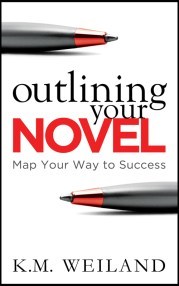 Unlike other aspects of the craft (e.g., the actual techniques and theories that build a story), the writing process is inimitably personal to each and every writer. Some writers, like myself, create processes that optimize upfront outlining and planning. Others find this utterly stifling to their abilities. Some writers require solitude and silence; others need the static noise of crowds or even TV in the background. Some writers crank out tens of thousands of words in a sit-down; others piece together only a few sentences a day.
Unlike other aspects of the craft (e.g., the actual techniques and theories that build a story), the writing process is inimitably personal to each and every writer. Some writers, like myself, create processes that optimize upfront outlining and planning. Others find this utterly stifling to their abilities. Some writers require solitude and silence; others need the static noise of crowds or even TV in the background. Some writers crank out tens of thousands of words in a sit-down; others piece together only a few sentences a day.
Writers sometimes resist the idea that creativity can be confined by rules. While this resistance is largely futile and self-defeating when it comes to the actual craft of writing, it’s absolutely worthwhile when it comes to the necessary individuality of the writing process.
Actually, there is one rule for writing processes, and this is it: Nobody can tell you or show you the right writing process for you. Every writer’s process will be slightly different, depending on any number of unique factors, ranging from personality to lifestyle. It can take time to create a writing process that will put you in the right place every time your fingers approach the keyboard. Likely, it is a process you will tweak for the rest of your life. As you evolve as a person and a writer, so too will your process evolve. Staying in tune with your personal needs and rhythms is the most important step in optimizing your entire life to help you write your best work.
Recognizing Writing as the Marriage of Order and Chaos
Much of the discussion about writing process comes down to whether or not an author finds it more comfortable to outline a novel upfront, or not. There’s a reason this argument is front and center. Within it lies one of the most foundational dichotomies of the creative life.
Chaos and order.
This everlasting, swirling dichotomy of power and control is one with which all writers are intimately familiar. Indeed, the best writing inevitably emerges from the tension point between chaos and order.
Creativity is the child of chaos; art is the child of order.
Raw inspiration is the intuitive understanding that funnels straight up from the subconscious. It is a chaotic experience. It is beyond our control, largely even beyond our comprehension. It’s a blinding swirl of light and color, images and feelings. It comes to us as little more than an unformed, inexplicable understanding. It’s often so fleeting we can barely grasp it on a conscious level. So many of these wild ideas fly away from us, like midnight dreams, almost before we remember they belonged to us at all. But in instances of great fortune, we hold the magic before our conscious mind’s eye long enough to capture it on paper.
In those moments, what we are struggling to do is bring order to chaos. We are taking the most ephemeral pantings of the human mind and confining them within the physicality of paper and ink. We are hammering them into the tiny, ever-tightening specificity of words. What begins as only the electric firings of our brains now becomes characters, plots, structures, stories.
This explains the almost unavoidable phenomenon Gail Carson Levine references:
Ideas are ideas, and words on paper are words on paper; they’re not the same thing, no matter how much we try to convince ourselves.
But both—the chaos of creativity and the order of art—are necessary if we want to create a book. Finding and balancing upon the tension point between them is where each writer’s personal writing process becomes crucial. For each of us, our best route to this end goal will be different—because for each of us, our respective relationships with order and chaos are different.
How to Upgrade Your Writing Process by Hacking Your Brain
Our brains all develop a little differently. We’re all wired in slightly—or, sometimes, dramatically—different ways. This is reflected in our personalities and, on an even deeper level, in our natural propensities and even skills.
Some writers will find themselves naturally wired to orient more naturally with the artistic order side of the coin, while others lean more freely into the chaos of creativity.
I daresay “order” writers are those who gravitate more naturally to the idea of incorporating upfront planning and outlining in their processes, while “chaos” writers are those who prefer to lean full-on into creativity’s wild ride, only straightening up their art later on.
Although you may instinctively know which approach best suits you, it’s not always so clear in the beginning. When trying to figure out your natural strengths, start by keeping in mind these two facts:
Fact #1: Neither is better than the other.
Both arrive at the same end goal, after all. To me, it seems possible that “chaos” writers more naturally retain the purity of their creativity, while “order” writers have a comparatively easier time getting their ideas into working order. Obviously, both approaches have inherent strengths and weaknesses.
Fact #2: Neither necessarily creates more or less work than the other.
All writers plan and all writers “pants”; all writers must embrace both chaos and order. It’s just that some writers prefer to impose order earlier in the process and others later. Whether you’re doing most of your heavy organizational lifting upfront in an outline or later on in revisions, the workload tends to even out in the long run.
What’s important is recognizing your most natural mode and experimenting with ways you can hack your brain’s personal wiring to create a writing process that will help you get out of your own way, while minimizing distractions and obstacles.
5 Questions to Help You to Create the Perfect Writing Process
Heeding your brain’s natural wiring is the first and most foundational step in creating your own personalized writing process. Once you’ve done that, start paying attention to your work flow and patterns. Take special note of what’s extra hard and what’s extra fun. What makes you most efficient? What helps you produce your best writing?
Slowly, you will be able to refine every part of your approach to optimize it to your own special needs. You can start by asking yourself the following five questions.
1. What Do You Find the Most Challenging Part of Writing?
A well-executed writing process won’t, in itself, make writing easy. But if you can identify the parts you hate most, you can work on minimizing them—and in the process, you’ll chop half your excuses off at the neck.
For example, I hate revisions. Let me say that again: I hate, hate, hate revisions. When writing my early novels, I sometimes had to completely rewrite them. And I loathed every single minute. It was torture. But over the years, I have learned how to optimize my process to eliminate as much of the major revision work as possible by focusing on an extensive outlining process. I spend the time in the beginning to get my story as close to perfect as possible, so I don’t have to put myself through the agony of major revisions later on.
Other writers, however, hate outlining with equal verve. In which case, vive la revision!
2. What Part of the Process Do You Find Most Enjoyable?
Another dichotomy of the writing life is that writing is often equal parts agony and ecstasy. Even as you try to create a writing process that minimizes the parts of writing you find agonizing, you are, of course, trying to maximize the ecstatic parts.
So what’s your favorite? What’s the one part of writing you could do all day, every day—if only you could? Start looking for ways to put that part of the process front and center. If you can figure out how to take care of the heavy lifting in your favorite part, you’ve just killed two birds with one stone.
For example, not so ironically, I adore outlining. It is far and away my favorite part of the process. I love it even more than actually writing the first draft. For me, spending months upfront doing something I love (which, in turn, is going to help me avoid doing something I hate) is no sacrifice.
By contrast, maybe what you enjoy most is drafting or even (gasp) revising. Figure out how you might be able to put the bulk of your efforts into this section of your writing. More time doing the thing you love best is just good for everyone.
3. What Are Your Most Obvious Weaknesses as a Writer?
As writers, we’re all evolving. Whether you’re a greenie just starting out or a certified black belt, you will always be adjusting your understanding of the craft (including the placement of that tension point between chaos and order). In short, you’ll always be learning how to do something better. Fortunately, this is another area in which you can optimize your writing process to help you move forward with the fewest possible obstacles.
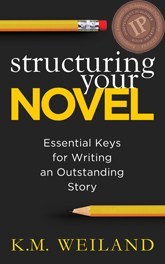 Look at your body of work—especially your most recent stuff—and examine it as objectively as possible. What do you believe are some of your most prominent weaknesses as a writer? This could be anything from story structure to chapter endings to minor characters to narrative description—or any combination thereof. How can you craft your writing process to help you deliberately focus on and improve these weaknesses?
Look at your body of work—especially your most recent stuff—and examine it as objectively as possible. What do you believe are some of your most prominent weaknesses as a writer? This could be anything from story structure to chapter endings to minor characters to narrative description—or any combination thereof. How can you craft your writing process to help you deliberately focus on and improve these weaknesses?
For example, something I’m working consciously to improve in my stories is the motivations and goals of minor characters, both in the larger story and scene by scene. I have consciously built into my outlining process the need to ask myself questions about all my minor characters. Instead of getting halfway into plotting the story before thinking about my minor characters’ personal agenda in any given scene, I’m trying to address these questions upfront, so not only will I know, but so these revelations have an opportunity to affect the entire story before I start plotting.
Similarly, you might try hacking your process to address weaknesses by outlining your story’s major structural beats or marking all descriptive passages for revision in later drafts.
4. What Is Your Ideal Writing Environment?
Setting up writing habits that include a daily schedule and optimized writing environment will contribute to the overall success of your process.
Once again, this comes down to observing yourself, knowing what triggers your best work, and avoiding what inhibits it. Depending on the circumstances of your home, job, and family, your choices may not always be optimal. But work with what you have. Insofar as writing is important to you, put in the effort to create the best habits possible. Nurture yourself.
 For example, although I’m a pretty routine-oriented person (“order” strikes again), I’m getting better at flexing my writing routine when necessary. Right now, as I’m outlining the third book in my Dreamlander trilogy, my favorite writing situation is a low-lighting setting of solitude, away from my desk and computer, with music filling the room. It makes me feel nested into a cocoon of creativity.
For example, although I’m a pretty routine-oriented person (“order” strikes again), I’m getting better at flexing my writing routine when necessary. Right now, as I’m outlining the third book in my Dreamlander trilogy, my favorite writing situation is a low-lighting setting of solitude, away from my desk and computer, with music filling the room. It makes me feel nested into a cocoon of creativity.
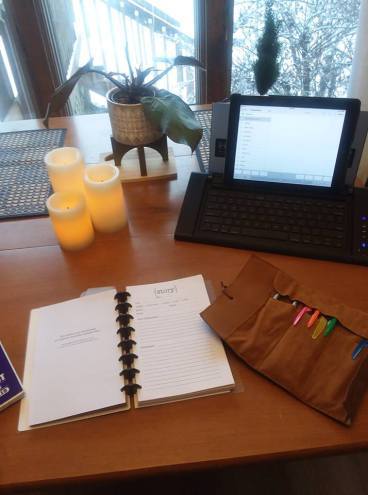
But others find they can’t write without background noise, even a TV show or movie running in the background. Or maybe you have kids and a day job and find your only opportunity for writing is getting in half an hour before the day’s other demands upon your energy begin. Whatever the case, try to give your creativity its best chance. Work with your life, not against it.
5. What Does Sustainability Look Like for You?
Recently, I read a brilliant quote on a sustainable lifestyle blog (not sure which one, unfortunately), which, paraphrased, applies equally to creating the optimal writing routine:
You’re not trying to be a perfect writer for a week; you’re trying to be an imperfect writer for the rest of your life.
Sometimes it can be easy to look at a famous writer’s book-stuffed writing nook, read their summary of their simple and seemingly effortless writing routine, and think, I should do that! I could totally do that!
And maybe you could pull it off for one day or even a couple weeks. If, however, the routine hasn’t been optimized to your individual needs as a creative person, it won’t be the long-term answer you need. Nurturing a personal writing routine is a lifelong pursuit.
Don’t guilt yourself into believing writing routines are a one-size-fits-all hand-me-down from the geniuses who have gone before. The first step is realizing this is your routine and, quite literally, no one else’s. Knowing this gives you the freedom to do what is best for you and only you.
How awesome is that? How often does life give you that kind of carte blanche?
Optimized writing routines don’t make writing easy, but they do make writing easier. So have fun. Embrace the chaos. Respect the order. Observe your own brain. Cultivate the ultimate space for enjoying your creativity and making your art.
Wordplayers, tell me your opinions! What is one thing you can think of that would make your writing process work even better for you? Tell me in the comments!
http://www.podtrac.com/pts/redirect.mp3/kmweiland.com/podcast/writing-process.mp3
Click the “Play” button to Listen to Audio Version (or subscribe to the Helping Writers Become Authors podcast in iTunes).
The post How to Create the Perfect Writing Process for You appeared first on Helping Writers Become Authors.
January 18, 2019
Who Won the Wayfarer-Launch Shopping Spree?
Thank you all so much for making the launch week of my new superhero-historical/gaslamp-fantasy novel Wayfarer a success. As always, your enthusiasm is what makes this all work! Thanks to you, the book jumped to #5 in Steampunk books on the American Amazon site.
It’s also been great hearing from so many of you who have either finished the book or are in the process of reading it. So awesome to hear you’re enjoying it!
And now the news you’ve been waiting for…
The winner of the $100 shopping spree is Brandon Perkins. Congratulations, Brandon! I’ll be emailing you directly about your prize.
The post Who Won the Wayfarer-Launch Shopping Spree? appeared first on Helping Writers Become Authors.
January 14, 2019
Announcing My Latest Novel: Wayfarer! (And Prizes!)
 Today, I am officially launching my fifth novel Wayfarer. Hooray!
Today, I am officially launching my fifth novel Wayfarer. Hooray!
If you’ve been following along on my journey with this book for the last several years, then you’ll recognize it as the one I keep referring to as my “historical superhero” novel. Set in 1820 London, it’s something I also like to cheekily think of as “Spider-Man meets Charles Dickens.” Turns out there’s actually a super-niche genre for this (which I had no idea about until I started researching keywords and categories on Amazon): gaslamp fantasy.
Best titled genre ever.
Basically, gaslamp fantasy is the more magical cousin of steampunk. Like steampunk, it is set in pre-industrial historical periods, but with less emphasis on steam-powered tech and more on magic or “mad science.”
Here’s the back-cover blurb:
Think being a superhero is hard? Try being the first one.
Will’s life is a proper muddle—and all because he was “accidentally” inflicted with the ability to run faster and leap higher than any human ever. One minute he’s a blacksmith’s apprentice trying to save his master from debtor’s prison. The next he’s accused of murder and hunted as a black-hearted highwayman.
A vengeful politician with dark secrets and powers even more magical than Will’s has duped all of London into blaming Will for the chilling imprisonments of the city’s poor. The harder Will tries to use his abilities to fight crime, the deeper he is entangled in a dark underworld belonging to some of Georgian England’s most colorful characters.
Only Will stands a chance of stopping this powerful madman bent on “reforming” London by any means necessary. Unfortunately, Will is beginning to realize becoming a legend might mean sacrificing everything that matters.
Read this new adrenaline-fueled historical superhero adventure today!
How Wayfarer Came to Be Written
My journey with this book started many years ago when I was sitting on the couch watching, for the umpteenth time, as Spidey swings through the closing scenes of Sam Raimi’s Spider-Man 2. Since I’m all about the historical aesthetic, I found myself idly wondering, How come no one has ever done a historical superhero? (As I would later discover, there have been many “historical” iterations, with Captain America’s steampunk jaunt through World War II being perhaps the most obvious current example.)
From there, my imagination took off. What came out is a book I’m very pleased with and proud of. It’s darker than some of the stuff I’ve written in the past, but also, I hope, deeper—while still being fun and funny and full of heart and adventure and a little romance. I feel it’s the best thing I’ve written to date, a representation of everything I know and believe about story.
How Wayfarer Came to Be Published
As some of you may have noticed, this book has had a bit of a winding way to official publication. I originally intended to launch it last fall before I moved—which might have worked if I hadn’t decided, at the last minute, to do some marketing experiments under a nominal pen name. So there I was in the midst of a huge move, also trying to launch a book under a pen name (some of you may have seen K.M. Wyland floating around Amazon), all while tweaking and examining metrics.
The idea was to experiment with separating my fiction “brand” from my non-fiction (similar to what Joanna Penn of the Creative Penn has done with her J.F. Penn novels). I entered into this with something of a “why not?” attitude. I didn’t have anything to lose except a little time and effort. With the leverage of Amazon ads and some targeted promos, maybe I’d notch my fiction sales up another level.
Basically, I wanted to see if I could launch the new pen name on the strength of ads alone, without the help of my existing platform, and with the ultimate intent of getting “clean” Also Bought recommendations on Amazon, which would better target my fiction to genre readers, rather than pointing back to my writing books. However, results were only so-so on that score. After the discount promos, I got some nice genre results in the Also Boughts, but my writing books also started showing up almost right away.
Add to that the multiple emails I started receiving from those of you who were concerned that:
a) my publisher had goofed with a huge typo on my book cover
b) I had an evil doppelganger who was trying to pirate all my sales
and… I decided it was all just too much trouble for too few results. It’s an experiment I’m glad to have checked off my list, but to tell the truth, I’m relieved I get to keep all my writing under the same name. Makes everything so much simpler. And I like simplicity!
Where Can You Buy the Book?
So you ready to start wayfaring?
If you’re excited to join the Wayfarer on his adventures, you can purchase the book at the following links:
(If you buy the paperback from Amazon, you’ll get the Kindle version for $.99 via their MatchBook program.)
If you don’t have a Kindle but want to take advantage of the cheaper e-book option, you can read Kindle books off your computer, iPhone or iPad, or Android, using their respective Kindle apps.
Enter to Win the Wayfarer Launch Prize
As always, I’m celebrating the book’s launch with PRIZES! So please join the party.
This time, I’m going to do something that (IMO, anyway) is totally fun: a shopping spree!
Instead of an upfront, one-size-fits-all prize, I’m offering the winner their choice of one or many of the fun writing/reading goodies from last year’s Christmas gift guide, up to a value of $100. In other words, if you win, you get to pick $100 worth of prizes from the list. A custom prize just for you!
(Due to shipping restrictions, the shopping spree will only be available to U.S. residents. International residents are still free to enter; in the event of an international winner, the prize will instead be a $100 Amazon gift certificate.)

Check out the gift guide post for full details, but the prizes available include:
Writing desk
Monitor stand
Bookcase
The Writer’s Map: An Atlas of Imaginary Lands
WriteMind Planner
Desktop decor
Bookend
Mug
Customized journal
Jewelry
Coffee spoon
T-shirt
Tote bag
Art prints
Phone stand/grip
Desktop organizer/planner
Q&A journal
Notebook
Mouse pad
Keychain
To Enter
Winners will be announced Friday, January 18th. You can do several things throughout the week to earn contest points and increase your chances of winning. For every contest point earned, your name will be entered once more into the pool (e.g., if you’ve earned 18 points, you have 18 chances of winning). (Note: no purchase is necessary to enter.)
Good luck to everyone in the drawing, have fun, and thank you for helping me celebrate the launch of Wayfarer!
The post Announcing My Latest Novel: Wayfarer! (And Prizes!) appeared first on Helping Writers Become Authors.
January 7, 2019
4 Things You Should Know Before You Quit Writing Your Novel
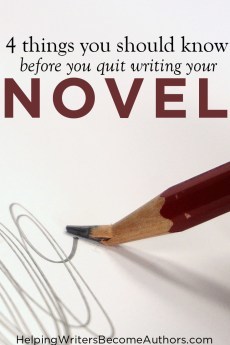 You began with high hopes.
You began with high hopes.
You envisioned a bestseller, imagined touring the country and meeting thousands of fans, even your own fawning relatives.
But now you’re stuck and wondering whether you should’ve even tried in the first place.
Maybe you ran out of story and have no idea how to salvage the mess you’ve created.
Self-doubt crept in, telling you your novel was no longer worth the effort.
As the author of 195 books, I can tell you you’re not alone. What I call the Marathon of the Middle—yes, that roughly half of your manuscript between your great opener and resounding closer—is one of the toughest challenges I face too—every time.
But in truth, everything about writing a book is hard.
If you’re on the verge of quitting for any of the reasons above—or myriad others, here are four things you can do:
1. Add Conflict
When my story stalls, it almost always needs conflict, what experts call the engine of fiction. Have your characters become too agreeable?
In real life, I love pleasant conversations, getting along with everyone. But in a novel, I look for undercurrents of opposition, tension, deceit, self-possession in every line.
Ask yourself:
What problems can I create for my characters?
Better yet:
What problems can my characters create for themselves?
Conflict doesn’t have to be loud or physical. It can be as subtle as a snide comment.
“Think you can hold it together at Christmas this year?”
The question is delivered from brother to sister with the requisite smile, your character pretending to be pleasant or perhaps teasing. But we identify with the sister, don’t we, and we’re insulted.
Maybe she smiles too and says flatly, “That depends.”
You see? Just dialogue, no action, but a scene fraught with conflict. Look at all those setups that demand payoffs. What was he implying? What must have happened last year? And what was she implying? It depends on what?
All of a sudden that story percolates. Merely banal greetings would have had us nodding off. But now we’ve been set up and anticipate more to come.
2. Face Your Fear
By now you know novel writing demands discipline. We all get discouraged along the way. But don’t quit! Soldier on! If it were easy, anyone could do it.
Afraid of failing? Quitting guarantees it.
Afraid you’re not good enough? That your story doesn’t work? You’re probably right! But don’t use fear as an excuse to quit.
Rather, use that fear to motivate you to do your best work. I’ve learned to embrace those fears, because they’re valid! Even with my experience, I know the competition is fierce and that other authors likely have better ideas. But there is something I can guarantee: no one will outwork me.
Are you with me?
3. Constantly Review
Read through what you’ve written and ask yourself:
What works?
What doesn’t?
Which passages do you love?
Where does your story stall?
Be brutally honest with yourself so you can aggressively, even ferociously, self-edit to where you’re happy with every word.
4. Trust Your Gut
Whatever you feel about your story your reader will feel 10 times over. I call this Reader Multiplication Syndrome.
If you’re worried a scene might fail to keep readers interested, you’re right. Attack and rewrite it till it works.
If you do dump a scene or even an entire manuscript, start a new one right away. You’re not quitting. You’re treating that misfire as valuable training.
I always feel like quitting at some point in the writing. It’s part of the process, an eye-opening obstacle I’ve learned to push through. You can too.
What Makes a Successful Author?
Finishing.
Just about anyone can start writing a novel. Precious few complete one.
Roll up your sleeves, get your seat in that chair, push through the Marathon of the Middle, and finish. You can do this!
If you’re looking for help writing a novel, I created an in-depth guide you can access by clicking here.
Wordplayers, tell me your opinions! Where are you with your work-in-progress? Tell me in comments!
The post 4 Things You Should Know Before You Quit Writing Your Novel appeared first on Helping Writers Become Authors.
December 31, 2018
Top 10 Writing Posts of 2018
 We’ve made it to the end of another year! I hope you’re able to look back at who you were at the beginning of 2018 and see many changes (for the better, of course!) in who you are now.
We’ve made it to the end of another year! I hope you’re able to look back at who you were at the beginning of 2018 and see many changes (for the better, of course!) in who you are now.
Honestly, I barely recognize the person I was back in January 2018. It’s been a huge year of personal growth for me, much of which either caused or was caused by an unexpected decision to move closer to my sister and her family.
As a result, much of my focus this year has been on external events more than book production. This is the first year in ten years in which I haven’t officially released a new book. I did unofficially release my historical superhero novel Wayfarer amidst all the craziness of my move this fall, but I did it on-the-hush so I could fiddle with some marketing experiments. I will be “officially” launching it sometime in January or early February at the latest.
Other stuff that happened for me this year:
Chinese translations of Creating Character Arcs
Finished first draft of my portal fantasy sequel Dreambreaker
5th mention of Helping Writers Become Authors in Writer’s Digest‘s 101 Best Websites for Writers
Other than officially launching Wayfarer any time now, my plans for 2019 include outlining the third and final book in the Dreamlander trilogy, as well as hopefully starting its first draft. I’m intending to focus most of my “business” time this year on odds and ends, such as moving the podcast to a better hosting platform, as well as doing more concentrated research on marketing keywords and perhaps even Amazon ads for my books (using Dave Chesson’s awesome KDP Rocket, which I’ll be reviewing in a post soon). For my next writing how-to book, I’m wanting to do something about theme, so I may start working on that toward the end of the year.
On a personal level, I’m becoming more and more committed to living a sustainable life with minimum waste (maybe someday I’ll get to zero waste!). I’ve already made huge strides toward swapping single-use products (such as napkins and tissues and even coffee filters) out of my life, in exchange for alternatives that can be reused many times (such as cloth napkins, handkerchiefs, and the awesome Coffee Sock). Getting better at finding food with zero or no plastic packaging is a goal for me this year, which also ties in with another of my personal goals: getting better at navigating and driving in unfamiliar places.
So that’s me this year! If you’d like to take a journey back through my top posts of 2018 (as judged by page traffic), check out the below list.
My Top 10 Posts of 2018
1. The 5 Secrets of Good Storytelling (That Writers Forget All the Time)
2. 5 Ways to Use the Enneagram to Write Better Characters
3. 5 Steps to Writing Great Character Chemistry
4. How to Intertwine Plot, Character, and Theme in Every Scene
6. 3 Tips for Improving Show, Don’t Tell
7. 4 Steps for How to Turn an Idea Into a Story That Rocks
8. 4 Ways to Choose a Better Theme for Your Book
9. The 10-Step Checklist to Writing an Above-Average Novel
10. 4 Ways to Write a Better Antagonist
Wordplayers, tell me your opinions! What was the most memorable writing event in your 2018? Tell me in the comments!
The post Top 10 Writing Posts of 2018 appeared first on Helping Writers Become Authors.
December 24, 2018
Merry Christmas!
Merry Christmas Eve, everyone!
I hope you’re finding time in this bustling season to pause, look around at your life, count your blessings, and express gratitude for them.
For me, Christmas has always been even more about thanksgivings than Thanksgiving. This year, I find myself increasingly thankful to get to take part in a creative lifestyle. Thank you for walking that road with me every day, even when we don’t see each other or make contact. I truly believe the work we are doing is one of the highest callings in life.
I’ll be taking a break from the writing to spend time with family and enjoy Christmas week. I hope you’re able to do the same, and I hope to see you in the New Year with pens sharpened, vigor renewed, and a thousand new stories waiting for us.
Merry Christmas and happy New Year, Wordplayers!

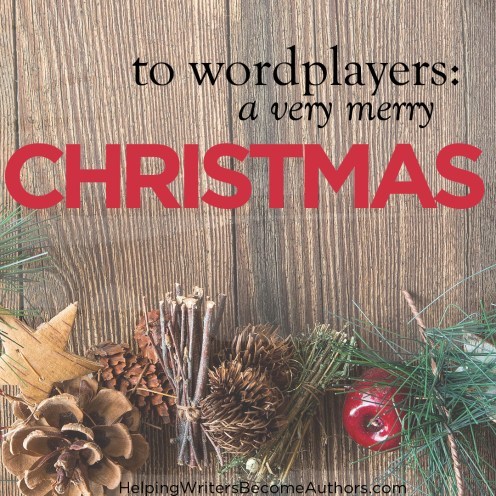
The post Merry Christmas! appeared first on Helping Writers Become Authors.
December 17, 2018
My Top Books of 2018
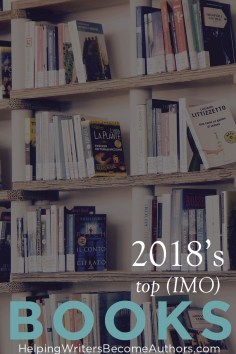 As we close out another year of reading, I find myself with a renewed appreciation and vigor for the importance and the blessing of reading.
As we close out another year of reading, I find myself with a renewed appreciation and vigor for the importance and the blessing of reading.
Having devoured books at the hungry pace of 100+ a year for at least fifteen years (I didn’t start keeping track until 2002), I’ve been feeling increasingly uncomfortable and even disturbed by the fact that my reading has fallen off to less than 50 books in the last couple years. This year—a year of big personal changes in my exterior world—was a year in which I struggled with the desire to even just sit down with a book. There was so much I wanted to read, but whenever it came down to it, I had a hard time doing it. (Cue inner panic!) Thanks to a Scribd subscription, I ended up listening to lots of audio books this year, which saw me safely through (and with three more books to my name than last year’s total!).
As I now close out the year, having settled in after a big move, I ecstatically find myself returning to a “reading space” for the first time in several years. Part of this, for me, was realizing and coming to peace with the fact that I will probably never reproduce my previous decade of “information inhalation.” I’m incredibly glad to get to carry the fruits of that decade with me for the rest of my life, but I’m no longer in a place where I’m seeking that of kind of prolificacy just for the sake of prolificacy. I’m learning (in no small part due to some of the books I’ll mention later in this post) to focus on turning my reading back into a joyous pastime rather than just another thing to triumphantly check off my to-do list.
One thing I’ve done is to change up my reading routine to make it more flexible within my daily schedule, sprinkling a chapter of this book and a chapter of that book here and there, while devoting evening reading solely to whatever is completely holding my attention (William Goldman’s hilarious Adventures in the Screen Trade at the moment).
So all in all, I count this one of my best reading years, more for how it’s ending than for how it actually went. That said, despite my struggles with reading this year, I find that it was a year rich in some incredible books (mostly the non-fiction), ones that I daresay will stick with me for the rest of my life.
Following you can find my top books of 2018: 5 Fiction Books, 5 Writing Books, and 5 General Non-Fiction Books.
But, first, the stats:
Total books read: 48
Fiction to non-fiction ratio: 26:22
Male to female author ratio: 27:21
Top 5 genres: Romance (with 8 books), Fantasy (with 6), History (with 6), Writing How-To (with 6), and Self-Development (with 5).
Number of books per rating: 5 stars (4), 4 stars (18), 3 stars (18), 2 stars (8), 1 star (0).
Top 5 Fiction Books
Honestly, it wasn’t a great fiction year for me (which, you may remember, is what inspired last week’s post: The 10-Step Checklist to Writing an Above-Average Novel). I didn’t read anything that ranked higher than four stars (out of five), but the following are my favorites of the bunch, all solid and worth reading.
1. The Commodore by Patrick O’Brian—Read 12-3-18

It is hard to overestimate my adoration for Patrick O’Brian’s unique, endearing, intelligent, and humorous Aubrey/Maturin series, about the Royal Navy during the Napoleonic Wars (brilliantly adapted into what is also one of my all-time favorite movies, Peter Weir’s Master and Commander: The Far Side of the World). The latter books (this is the seventeenth installment) don’t have quite the same sharpness as the earlier installments, but this episode is as charming as ever, although featuring one of O’Brian’s more rambling and anticlimactic plots.
2. The Last Wish by Andrzej Sapkowski—Read 7-28-18

I got a lot of enjoyment out of this series of connected short stories, set in an epic fantasy world. The protagonist is a great character, the settings well-realized, and the action interesting. It’s the same ol’, same ol’—and yet totally not. (I listened to this on audio, and the narrator was excellent.)
3. The Last Convertible by Anton Myrer—Read 3-6-18

This one isn’t as razor-sharp as Myrer’s war critique Once an Eagle (which was my #1 book in 2016), but it’s still an interesting look at both the World War II generation and the progression of life from idealistic youth to realistic middle age. It just barely avoids being soapy in places, but is always enjoyable.
4. Age of Innocence by Edith Wharton—Read 6-1-18

After taking a break from the classics for about six months this year, this was my first foray back. After all that time away, it was surprisingly comforting to be once again surrounded by the lush reliability of excellent storytelling and powerful wordcraft. This is a book well-deserving of its acclaim: a societal critique that remains pertinent and thought-provoking even today.
5. The War of the Worlds by H.G. Wells—Read 8-9-18

This book is rightfully a classic. Presented in hyper-realistic details, it is a gripping and chilling account. It lacks something in the way of character or, really, plot, but it’s still fantastic.
Top 5 Writing Books
In contrast to my somewhat ho-hum experience with fiction this year, my experience with non-fiction was fantastic. This is particularly true of writing-craft books—which account for all my five-star ratings this year. I’ve decided to divide the writing-craft books into their own category, so I can also share some of my non-writing favorites (see General Non-Fiction below), but, first, here is the best of the best of my reading this year.
1. Walking on Water by Madeleine L’Engle—Read 7-18-18

This book is an intuitive artist’s dream: incredibly beautiful, insightful, and inspiring. I listened to it on audio the first time around, but before I was even halfway done, I ordered a hardcover so I could re-read it and underline it liberally. I’m currently working my way through it again, bit by bit, and enjoying it even more (if that’s possible) the second time around. I’m sure this is the first of many re-readings.
2. Light the Dark edited by Joe Fassler—Read 1-1-18

Usually, I avoid anthologies. Too often, they’re uneven and random. This one, however, is an incredibly special exception. Let me explain with an anecdote: instead of highlighting passages I enjoy, I sometimes use “book dart” bookmarks. Well, by the time I finished this book, I only had about four book darts left in the tin.
There’s just so much to love in this book. We get to hear from so many great authors commenting not so much on the process of writing, but on the life of artistic pursuit, their own inspirations and influences, and their discoveries about what it means to write. The range of perspectives is vast. It’s interesting to see where they contradict each other and where, in some instances, they agree with each other almost word for word.
I was deeply inspired by this book—as evidenced by the many posts it prompted either directly or indirectly, most notably these two:
>>The Words That Changed Your Life: Discovering What Made You a Writer
>>4 (Possible) Reasons Why We Write
3. Book Girl by Sarah Clarkson—Read 10-30-18

Sarah Clarkson speaks to me. In both the books I’ve read from her (the other being Caught Up in a Story, which was my top writing book in 2016 and was partially responsible for one the posts I’m still most passionate about: 5 Reasons Writing Is Important to the World), it’s like someone has looked into my head and described my experiences with a greater emotional understanding than I had for myself.
In both instances, her books came to me at opportune moments, when my life was in flux, with me standing at a crossroads of some sort. I read this one after a significant move—and, as I mentioned earlier, after several years of struggling with the motivation to read. Her ode to words and stories and her loving lists of great books—so many of which I’ve already read—has reinvigorated the reader in me. I don’t think it’s too much to say that her first book changed my life; this one did too.
4. The Art of Memoir by Mary Karr—Read 8-9-18

Another reviewer of this book said she wanted to underline every word. I felt the same; since I was listening on audio, I promptly bought a copy, so I could do just that. Even if you’re a novelist and not a memoirist, as I am, this is a brilliant book, full of spot-on advice and one of the best and most applicable challenges to story integrity I’ve ever heard.
5. Nabokov’s Favorite Word Is Mauve by Ben Blatt—Read 6-6-18

This offers entertaining and fascinating stats that provide an insightful “behind the scenes” look at what makes great books and authors tick.
Top 5 General Non-Fiction
1. The Road Back to You: An Enneagram Journey to Self-Discovery by Ian Morgan Cron and Suzanne Stabile—Read 4-14-18

This book provides sound basics of the Enneagram personality typing system. It helped me find my own number (3w4) and opened my eyes to areas of personal understanding and growth I hadn’t previously considered. Originally, I only gave this (and the following Enneagram book) a four-star rating. But in hindsight, I realize these books have stuck with me more strongly and provided many more life-changing insights than some of the books I initially liked more.
2. Personality Types: Using the Enneagram for Self-Discovery by Don Richard Riso—Read 7-10-18

This book provides excellent in-depth information on the Enneagram system. There’s tons of good stuff here, although I did feel it placed too much emphasis on a descent into psychosis rather than a rise to health. However, thanks to its handy organization, I feel this book is a particularly good aid for writers creating characters, which I talked about in this post: 5 Ways to Use the Enneagram to Write Better Characters.
3. A World Lit Only by Fire by William Manchester—Read 11-20-18

Insightful and entertaining at every turn. A great and thought-provoking overview of the Renaissance period.
4. 12 “Christian” Beliefs That Can Drive You Crazy by Dr. Henry Cloud and Dr. John Townsend—Read 5-29-18

This is the perfect follow-up to the authors’ life-changing book Boundaries (which was my top non-fiction book in 2017). It offers excellent advice that busts through a lot of beliefs many of us, regardless our worldview, take for granted.
5. The Crusades by Zoe Oldenbourg—Read 4-5-18

I read this book long ago and far away when researching my medieval novel Behold the Dawn. Upon re-reading it, I found it deeply engaging and interesting in some places, while dry and too reliant on a confusing blur of names in others. Overall, it is still one of the best books I’ve ever read on the subject and entirely enjoyable in its own right.
Honorable Mention: Savage Continent: Europe in the Aftermath of World War II by Keith Lowe—An incredibly insightful overview of the post-World War II horrors most of us tend to overlook. Difficult to read at times, but extremely important.
My Books
And if all these goodies aren’t enough to fill your To Be Read pile this year, here’s a few more! 
December 10, 2018
The 10-Step Checklist to Writing an Above-Average Novel
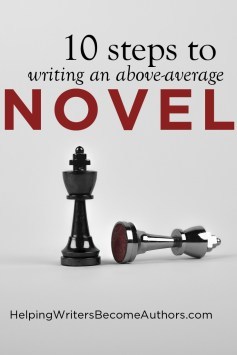 “Anybody can write a novel.” Writers sometimes hear that statement from dismissive non–writer family and friends. Rightfully, we dislike the insinuation, since we know full well how much education, talent, skill, effort, and dedication is required for “anybody” to write a novel. Still, there is a certain measure of truth in the idea that “anybody can write a novel.” An average novel, that is.
“Anybody can write a novel.” Writers sometimes hear that statement from dismissive non–writer family and friends. Rightfully, we dislike the insinuation, since we know full well how much education, talent, skill, effort, and dedication is required for “anybody” to write a novel. Still, there is a certain measure of truth in the idea that “anybody can write a novel.” An average novel, that is.
A above-average novel though?
That’s something else again.
Or actually, is it?
I believe every one of us has the opportunity to write not just write a book, but something that rises above the pack to truly meaningful and impactful storytelling.
But doing so starts by recognizing the common mistakes, pitfalls, and stereotypes that dog mediocre fiction.
Get Started on a Amazing, Above-Average Novel With These 10 Steps
First: a little personal background on this post. For me, this year was one of major transitions, including a big move. As a result of all the craziness going on in my outer life, I wasn’t feeling too ambitious in my reading (although I did crack Proust). This year, I read a lot of what I call “popcorn” fiction. In other words, easy reads. And… I was disappointed by almost all of it.
The problem wasn’t that these stories were lightweight—that’s exactly what I wanted them to be. Rather, the problem was that they all suffered from unnecessary contrivances and cliches. And the most interesting thing was that, for the most part, they all suffered from the same contrivances and cliches, regardless of genre.
Now, before someone comes back with the inevitable response that “lightweight” fiction need not be concerned with the finer nuances of great literature, let me put forth my absolute disagreement. We need good fiction. We need cerebral classics like Proust’s monumental In Search of Lost Time, but we need good “light” fiction just as much. Indeed, “light” fiction has the opportunity to be tremendously impactful, if only because it is so accessible.
Just as much as we need heavy-duty stories that offer complicated critiques of society, we also need simple stories of romance and adventure—ones that are not dumbed down or sloppily presented. Entertainment and intellectualism should not exist at polar ends of the spectrum.
The most intellectual fiction should optimally be the most entertaining. And the most entertaining of our stories should optimally be the most impactful.
That’s why today I’ve collated some straightforward solutions to the top ten problems I noticed in “average” fiction this year. The primary antidote to almost all these problems is simple awareness. If you, as an author, can learn to spot these problems, analyze their existence in your own stories, and consciously work your way past them, you’re well on your way to writing an above-average novel.
1. Have a Plot
This one should be obvious—especially to writers of genre books. But not so much, apparently.
So what is plot? That question, of course, is one we talk about a lot on this blog (most recently in this post: How to Choose Your Story’s Plot Points). But today I’m going to sum it up like this: plot is a well-structured story with a cohesive point.
Most genre stories at least pretend they have a plot (the boy and the girl fall in love, the space captain fights the aliens, etc.). But too few execute that plot consciously on every page and every level of their story (i.e., plot > character > theme). Too many rely on random events and coincidences (e.g., the boy and the girl just happen to keep bumping into each other around every corner) that strain suspension of disbelief.
2. Give Your Characters Strong Desires and Goals
The fastest route to a solid plot is via your characters’ desires. What do these people want? I don’t mean some general principle like love or peace. And I don’t even mean just a plot goal (e.g., kill those aliens!). I’m talking about making sure every scene features a solid, driving, urgent desire and a resultant goal.
Too often, writers let characters wander around aimlessly (e.g., the depressed female lead is staring out over her favorite view of the Golden Gate Bridge again) or with only nominal goals (e.g., the space captain is on a routine inspection). This can be because the authors didn’t originally know what was going to happen next. Rather, they just turned their characters loose on the page and waited to see what happened. That’s fine in the first draft, but the rambling needs to be cleaned up in subsequent drafts.
Give every single character in every single scene a strong desire and a related goal—then turn them loose on each other.
3. Make Sure Your Characters Spend More Time Doing Stuff Than Talking About a) What They’ve Already Done / b) What They’re Going to Do
Whenever I find myself reading a needlessly wordy, rambling narrative in which nothing is actually happening, I often think of the wise words of Mattie Ross in True Grit:
I’m not paying for talk!
A character’s internal narrative is important. Readers want to understand a character’s inner landscape and inner process. In the hands of the right author, this kind of internal narrative can, in fact, make up the majority or even the entirety of the book (although never, I daresay, in genre fiction).
However, it’s important to note that characters who are interesting enough to move the story forward via large chunks of meaningful philosophizing are entirely distinct from characters who sit around rehearsing unnecessary information.
The greatest culprits of “unnecessary” information fall into the following two categories:
1. Backstory
Learning how to properly disseminate backstory information is an important (and often tricky) skill for authors. My rule of thumb is “never share backstory until it is necessary to the plot; until then, just drop delicious hints.” But even if you have, in fact, waited until the perfect moment to share backstory, you must still be on guard against repeating it. One book I read this year spent what I estimate was fully a quarter of its word count having its protagonist either think about or talk about her tragic backstory—the same information over and over and over again.
2. “Sequel” Scenes
The “sequel” half of scene structure (i.e., Scene: Goal > Conflict > Outcome; Sequel: Reaction > Dilemma > Decision), in which characters react to previous events before deciding how to respond, is vital to a well-structured story. So much character development happens in these scenes. They are also vital to creating a sense of realism via an unbroken chain of cause and effect.
However, it is far too easy to fall into the trap of using these scenes either to simply rehash the dramatic events that just happened or the characters’ plans for what will happen. Both of these almost inevitably fall into the category of “telling.” Readers only need to be told once—and when you can show them instead of telling them, always show them.
4. Ruthlessly Chop Dramatic Subplots That Only Exist to Create Exciting Climaxes
An oft-referenced screenwriting principle is that of creating an emotional “B story” to augment the plot’s main “A story.” Although this approach offers some immediately practicable benefits, I dislike its suggestion that there can be “two stories.” Bottom line: every piece of your story must contribute to the big picture of plot and theme. If any subplot doesn’t do that, then it doesn’t belong.
Very often, genre stories will include a suspense subplot (commonly seen in romance novels) or a relationship subplot (commonly seen in action novels), either of which matters very little, if at all, to the story’s overall thematic presentation. That’s problematic in itself, but when these decidedly minor subplots are then leveraged into the all-important limelight of the Climax, just to provide an extra punch at the end, the story’s overall cohesion fractures all the more.
5. Make Your Characters Earn Their Romances
If your story features a romance, make sure you’re representing it with realistic nuance. Create realistic relationships, in which both people fight their demons in order to be together; in which both people make mistakes and suffer the consequences; in which both people have to earn their happiness together. Because, seriously, I swear I’m gonna die if I read one more wish-fulfillment romance in which some ridiculously hot, but utterly vapid guy doggedly pursues a self-absorbed heroine just because she’s the heroine. (And vice versa.)
6. Give Every Character Someone to Talk to
What’s the most interesting part of a story? Everybody’s mileage is going to vary a little on this one, but I’ll bet most of us would agree our favorite parts are where characters get together and talk to each other. Dialogue is one of the most entertaining and most utilitarian aspects of any story. So much can be accomplished with good dialogue—everything from character development to plot advancement.
But this only works when one character has another character to talk to. And it works so much better when the two characters doing the talking actually have a relationship of some sort and therefore something at stake within the relational aspect of the scene.
This seems like a no-brainer, but it’s amazing how many books scatter their fantastic characters to the four corners of the globe, effectively preventing them from talking to each other for the entirety of their stories. So just tell me this: which would you rather read: a story in which the two best characters talk to each other regularly—or a story in which they don’t?
Put your best characters in a room together. If you can’t do so for plot reasons, then it’s time to create another interesting character.
7. Include Only Purposeful POVs
Point of view is a complex subject, so I’m not even going to get into basic principles and pitfalls, such as avoiding head-hopping. Rather, since this is a post about how to make the jump from average fiction to above-average, I’m going to talk about a one-up tactic: managing POVs to create an overall effect.
In short, don’t include scenes from random POV characters. Even those characters whose viewpoint you purposefully choose to use throughout the story need to be chosen to carefully present the plot to optimal effect. Recent trends aside, the best principle for above-average POV usage remains: the fewer, the better.
8. Make Sure All Characters Have Agency
Something I’ve been thinking about a lot lately is Karpman’s “drama triangle”—a social model that calls attention to the negative ramifications of casting ourselves and others in one or more of three relational roles: villain, victim, and hero.
So many of our accepted narratives are hero-based: somebody needs to be saved, so somebody else has to do the saving. Although this model certainly lives up to its name in providing drama, it also further ingrains social mindsets that are ultimately damaging.
Recent decades have offered a lot of kickback against the presentation of female characters in the victim role of a “damsel in distress” who needs to be saved by a “hero.” I believe this idea should extend to all your characters. Naturally, it’s only realistic to put certain characters in situations where they require aid (even rescue) from other characters, but challenge yourself (as I’m currently trying to do myself) to make sure all characters have agency. All characters—even those most physically helpless—should be given responsibility for their own fates. It’s phenomenal how much character development can result from just this simple mindset tweak.
9. Play By Your Own Rules
This one is important for all authors, but particularly for those writing multi-book stories. Whether you’re creating complex magic systems or simply sharing a character’s backstory or even just applying foreshadowing hints in the first part of a story—you must be consistent. Readers trust you. They believe that what you tell them is so. If that turns out to not be the case, even if it’s just the result of negligence on your part, the results can vary from a simple intellectual wrinkling of the nose to an emotional chucking of your book. Either way, it’s not in anybody’s interest. You made these rules for your story; it’s only fair you remember to follow them.
10. Have Style
You can get an A+ on all of the previous nine principles of above-average writing, but it probably won’t matter if readers end up labeling your book “bland.” Truly memorable stories are usually less memorable for what they share than they are for how they share it. This doesn’t (necessarily) mean you need a gimmick, but it does mean you need panache. This starts with creating charismatic characters, moves on to find its foundation in solid control over every structural decision, and ends with a distinctive narrative voice.
***
Ultimately, being able to write an above-average novel requires nothing more than the commitment to keep learning what an excellent story looks like—and doesn’t look like. Keep your writerly brain turned on whenever you read a new book. Take note of what works for you, what doesn’t, and how you can employ those lessons in your own fiction to strengthen the best bits and eliminate the weak parts. Here’s to each of us writing our personal best story in the coming year!
Wordplayers, tell me your opinions! What is a common pitfall you noticed in the novels you read this year—and why do you think it kept these books from being as good as they might have been? Tell me in the comments!
http://www.podtrac.com/pts/redirect.mp3/kmweiland.com/podcast/above-average-novels.mp3
Click the “Play” button to Listen to Audio Version (or subscribe to the Helping Writers Become Authors podcast in iTunes).
The post The 10-Step Checklist to Writing an Above-Average Novel appeared first on Helping Writers Become Authors.
December 3, 2018
The 10 Rules of Writing Large Casts of Characters
 Large casts of characters are the thing these days. Rowling, Martin, and Marvel—just to name a few newsworthy examples—victoriously (and sometimes not-so-victoriously) throw casts of hundreds at screen and paper. Understandably, writers rush to emulate—both because, on a head level, this seems like the obvious path to success, and because, on a heart level, we like these stories and instinctively want to recreate their enjoyable patterns.
Large casts of characters are the thing these days. Rowling, Martin, and Marvel—just to name a few newsworthy examples—victoriously (and sometimes not-so-victoriously) throw casts of hundreds at screen and paper. Understandably, writers rush to emulate—both because, on a head level, this seems like the obvious path to success, and because, on a heart level, we like these stories and instinctively want to recreate their enjoyable patterns.
It sounds straightforward enough until you round up all your suspects in one room and try to organize their chaos of conversation. And multiple-character dialogue sessions are the easy part. Once you start factoring in each character’s personal contribution to plot and theme, the inside of your brain can end up looking like John Nash’s secret shed.
Recently on Facebook, Claire Lauzon messaged me:
I’m writing a novel about a heist and I have so many characters (20+) involved in this heist that it becomes very difficult to deal with. Have you written an article describing how to tackle this problem? I can see it in my head as if watching a film but putting it in writing is another story.
10 Rules for Handling Large Casts of Characters
Despite being a vocal proponent for small casts (more on that in a sec), I tend toward relatively large casts of characters in my own stories. The just-finished first draft of my portal fantasy sequel Dreambreaker features nearly 70 named characters, almost all of whom appear repeatedly throughout the story.
Today, let’s talk about what I’ve learned over the years about managing large casts of characters—and how you can employ a couple important rules of thumb to you help you manage your own teeming call sheets.
Rule #1: Characters Should Exist to Represent Theme and Move Plot (Preferably Both)
The first and single most important principle to consider when evaluating the size of your cast is this: does each character matter to this story?
Characters, like any element in a well-thought-out story, should never be throwaway additions. Each must contribute to the story. Sometimes this contribution may necessarily be as small as a few catalytic or informational lines in a one-off scene. But the more screentime characters have, the greater your responsibility to make sure they contribute to the story on a larger scale.
It’s not enough for prominent characters to exist in the story merely to move the plot; they must also influence and comment upon the thematic argument, either symbolically or by directly impacting the protagonist’s personal arc of growth.
Rule #2: Fewer Characters Are Better
By extension of the above, here’s a truth some authors don’t like to face: fewer characters really are better. The tighter your cast, the tighter your story’s focus—in both its presentation of a forceful plot and its thematic argument.
On a practical level, small casts aren’t always possible. For example, you can’t tell an epic story about multiple kingdoms at war without a cast of hundreds or even, technically, thousands. In these cases, you will need a substantive cast simply to convey the weight of the story’s events.
But even in these instances, it’s almost always best to whittle the active cast down to a smaller handful that can represent the greater event happening in the background.
Always ask yourself: what is the fewest number of primary characters necessary to tell this story to its optimum? Any more than that, and you risk clutter.
Rule #3: Avoid Repetition by Recognizing Which Archetype Each Character Represents
Planning an optimally-sized cast begins by recognizing the archetypal roles of characters within stories. Specifically, I’m talking about the broadest of all story archetypes—protagonist, antagonist, and relationship catalyst. Every single character in your story will (or should) represent one of these primal thematic forces.
>>Read More About the 3 Character Types
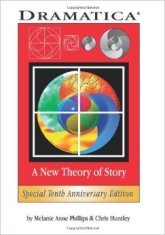 From there, we can expand the three primary story forces into a slightly broader exploration of the perspectives that will fully flesh out your story’s thematic argument, ensuring your plot is covering all its bases. These archetypes (based in large part on Dramatica‘s exploration) are:
From there, we can expand the three primary story forces into a slightly broader exploration of the perspectives that will fully flesh out your story’s thematic argument, ensuring your plot is covering all its bases. These archetypes (based in large part on Dramatica‘s exploration) are:
Protagonist
Antagonist
Sidekick
Skeptic
Guardian
Contagonist
Reason
Emotion
Love Interest/Relationship Character
These roles can overlap or be represented by multiple characters. However, in recognizing where you have two characters playing the same role (particularly when they consistently show up together in the same scenes), you can often tighten your cast by eliminating the repetition.
>>Read More About the 8 1/2 Character Archetypes
Rule #4: Identify Which Characters Play a Role in the Climax—and Prioritize Them
Another way to determine whether your large cast is justified is by following all of your characters to the end of the story. What is their role in the Climax? As the ultimate payoff of all foreshadowing in your story, the Climax dictates what elements deserve a place in the previous acts. Characters who have no role in or impact upon the final climactic encounters are probably characters who are not strictly necessary to your story.
On the other hand, those characters who do significantly play into the Climax or the scenes leading directly up to it—these characters are ones you should be taking very good care of throughout the story. These are the characters who matter to your story.
As such, they need to be properly developed throughout the story—preferably in all three acts. Even in situations where you’re unable to give these characters a lot of screentime throughout, they should at least make an appearance and/or a sizable contribution in each act.
Rule #5: Keep a Firm Grasp on Which Character Is Your Protagonist
One common pitfall with large casts of characters is losing the forest for the trees. However, the larger your cast, the more important it is to ground your story with a solid protagonist. This is the character with whom your readers will relate; this is the lighthouse in the storm. More than that, the protagonist is the character who ultimately defines both the main conflict and the theme.
If you’re uncertain which character is your protagonist, look again to the Climax—specifically, the Climactic Moment. The protagonist is the character who initiates and/or is most strongly impacted by the final resolution of the conflict and/or represents the final thematic outcome. As such, this character needs to be given prominence throughout the story, specifically at the major structural moments. Even the largest cast can be grounded when placed within a solid structure that keeps its primary focus on the protagonist.
Now, it’s true many prominent examples of large casts—including Martin and Marvel, aforementioned—don’t really seem to follow this rule (although arguments can be made). In my opinion, their stories, despite their many good qualities, ultimately suffer as a result. Rowling (at least in the old days) is a stalwart exception, whose clear protagonist, and thus thematic, throughline perfectly grounds her mammoth casts.
Rule #6: Chart Each Prominent Character’s Personal Goal and Personal Conflict With the Protagonist—and Every Other Pertinent Character
Even after you’ve conscientiously examined and streamlined your cast down to its optimal fighting weight, you may very well still end up—as I often do—with a story that features dozens of prominent speaking roles. So how do you manage them?
Start by managing the characters’ throughlines. Remember: your minor characters’ most important distinguishing factor is their relation to the protagonist. It’s not enough for minor characters to simply be present in the story, nominally either for or against the protagonist’s goals. These characters should have distinct, concrete goals of their own. These goals should have a specific relationship to the protagonist’s goals and, in turn, to every other pertinent characters’ goals. And, naturally, you’re always going to get a little extra honey on your bread if you’re able to engineer a whiff of conflict even between allies.
Understanding your minor characters’ goals is the single most important step you can take in making sure every character—no matter how many—contributes to the larger story, rather than just being a benign space filler.
Rule #7: Space Out Character Introductions
Once you’ve got your cast planned and you’re ready to get down and dirty with the actual writing, unique challenges emerge. One of the first has to do with how to introduce readers to so many characters. The rule of thumb is simple: space out introductions.
Sometimes this takes planning. You will have to carefully engineer your early scenes to:
create plot-pertinent events that
allow you to introduce as many important characters as early as possible
with pertinent characteristic moments
and without lumping them all together too quickly.
There is no one right way to do this. But a good place to start is by making certain each character you introduce has a stake in moving their first scene forward in some way. A careful use of setting can also be useful. For example, if your story is about an army company, you can avoid introducing everyone right off by separating them. Maybe in the beginning, the captain is in his tent with his adjutant, then one of the soldiers comes in with a message, before finally the captain goes out to talk to the rest of them.
Rule #8: Lump Similar Characters Together by Characterizing Them as a Group—and Appointing a Spokesperson
Sometimes casts end up being large not because every character is important, but because the group is important. For example, you can’t tell a war story without huge armies. But every soldier in those armies need not be personally named or fleshed out.
Even within smaller, more intimate groups, in which it is necessary to name many or all of the characters (such as our story about the captain and his company), it will often be to your advantage to create groups and sub-groups that can be either represented as a whole or represented by a spokesperson character. For example, instead of characterizing all 80 men in the captain’s company, you could break it down into squads, with sergeants and lieutenants representing their men.
Rule #9: Know What Each Character Wants and/or Has at Stake in Each Scene
Characters are no good to you if they aren’t contributing to every scene in which they are present. If they aren’t there to do something, then they’re just in the way. (There are exceptions to this, obviously, such as large-scale events such as weddings, which require supporting characters merely to observe.)
If you’ve done your homework (see Rule #6, above), then you already have a good idea what each character wants and therefore what is at stake for each character in any particular scene. Now you get to put that knowledge to work. Instead of a one-on-one argument between protagonist and antagonist while side characters merely look on, now you have the opportunity for a complex representation of conflict and theme, with every character invested in what’s going on.
And if it turns out a particular character really doesn’t have anything to add to the scene’s conflict and progression? Well, it could be that person isn’t necessary to this scene (or the story?) after all.
Rule #10: Employ Dialogue Tags and Action Beats Judiciously in Multiple-Character Conversations
And now we return to one of the most obvious challenges of large-cast stories: multiple-character conversations.
Let’s say you’ve pulled off the kind of scene we talked about in the previous section: a confrontation that involves not just the protagonist and antagonist but every character present. How do you juggle all that dialogue without confusing readers?
Frankly, it ain’t always easy. But you can help readers avoid confusion by judiciously using dialogue tags (he said). Action beats (she clenched the edge of the counter) are even better, since they also offer the opportunity to keep readers grounded in the setting and other sensory details.
The more characters you have present in any scene, the trickier the choreography gets. But as long as you know exactly what role each character is playing, you will have a much better chance of keeping things as focused and powerful as possible.
***
Stories with large casts of characters offer many challenges. Even the simplest story requires dozens of complex working parts; the more characters you add, the more you exponentially increase your own challenges. However, when done well, large casts bring depth and heft to your story. Make sure you’ve considered the above rules, then gather your characters, and start partying!
Wordplayers, tell me your opinions! Do you like to feature large casts of characters in your stories? Why or why not? Tell me in the comments!
http://www.podtrac.com/pts/redirect.mp3/kmweiland.com/podcast/large-casts-of-characters.mp3
Click the “Play” button to Listen to Audio Version (or subscribe to the Helping Writers Become Authors podcast in iTunes).
The post The 10 Rules of Writing Large Casts of Characters appeared first on Helping Writers Become Authors.







